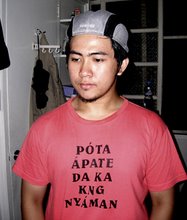Bayu Melasakneng Jason Paul Laxamana
Ing tagimpan ku kanita, maging ikata.
Asna kang ka-cute. Asna kang kaganaka. Asna kang kasikan lub mangabit matuling a lipstick potang lulub ka UP. Atin pánga-punk ing kekang fashion sense. E na mákapakirut kasi bokalista na ka ning metung a bánda. Oneng kalupa na pin ning amanuan mu king Friendster, trip mu mu ing makanitang imalan; e ka maniwalang ita ing pipamantayan ning pamaging rakista. Tsk. Inya naman crush da ka e.
Inyang king ku pang UP Pampanga, atin tamung reporting king Com 2 kanita. Asna kung katamad panigaralan ing report ta inyang aldo bayu ing pamag-report. Kayi bigla kang mig-text. Pápasaup ka king aldong tutuki para king kekang report uling e ka mipaindatun isip uli ning pate yu ning tau mu.
Inya menigaral ku.
King aldong katuki nita, sinulud ke ing bayu kung asul a baru. Kalub ku library, sabi mu cute ya ing imalan ku. E ku na mu asabi, cute ka mu naman kanita.
Corny ku, ne?
Metung naman a bengi king Quezon City, Third Exam ku king tutuking aldo kanita king PolSci 14 inya pákakalat la ngan ding readings at lecture ku king lamesa king sála ning boarding house, kawalu ning bengi. Pákasadya na ing kape king lele kasi pilmi kung maging na ku na naman Master Showman king benging ita (“Walang tulugan!”). Kayi mig-text na ka’ kabud. Syempre mekibat na ku man. Kaibat, migbabad ta na king pamag-text! Makatula la ring kekatang sasabian king balang metung. Dakal ku abalu tungkul king biye mu – king masikan mung ilig king pamanigtig, king protesta nang ibpa mu king ilig mu, at aliwa pa. Pati itang lihim a kasulatan a kinudta ku kanita tungkul keka, apisabian ta mu rin. Ing masanting keta, cool ka mu tungkul keta.
“E ku na mu asabi kekang apaninapan ku mu rin ing mitáu kata kasi pota mag-freak out ka,” ngaku pa.
“Ali naman. Astig pin e.”
Inya naman e ku rugu mekapanigaral manggang 11 nin bengi. Ambuski manga 20 minutu kata mung “mísabi,” metung a oras kaibat na nita, dikal na mu mamaglundag ku king ligayang dela ning simpling pamipangamanung ita. Sigi na pin – wa, memaglundag ku talaga.
Corny, ne?
Sembreak inyang mílabas a banua, tatali ke pa ing buak ku king gulut. Mig-get together tamung mikakaluguran UP Pampanga king Fontana, overnight. Aku, ika, ing tau mu, at aliwa pang kaluguran. Wa, ati yu ing tau mu. Iya ing menakit ketang lihim a kasulatan kinudta ku dikil keka, dikil kekata. Syempre e ku mipaindatun. Kayi uling mamulang ku, e da ka mo pinansin mabilug a bengi. Inyang minuna kung abalitan a kinalat ya itang sulat kung ita, medyu mig-panic ku. Oneng keluatan, ayisip ku, bakit ku tumakit karing sarili kung amanu? Tutu la ngan deta.
Atin oras a ikata mung adua king sála: aku, mánalbe kung Starstruck Season 2 at pánenayan ke ing pamaglage nang Chris Martin bang págsisti, kabang ika, atin ka yatang babasan o mánalbe ka. Pakisabian da ka sana, oneng praning ku king tau mu.
Pulus tamung alang agawa inyang linalam pa ing bengi, inya naman memialung tamung Spin-the-Bottle. Red Horse Bottle. Truth or truth, alang consequence. Apiyikit-ikit ku nang makulkul ya ing personal kung biye (a masalese kung sasalikut karing tau), pero salamat king Red Horse, sinikan-sikan ing lub ta. Mumunang inum ku pala ita king ganap kung biye.
Mumuna da mu rin ikit ding tau ing metung kung dakeng e da sukat isipan atin ku.
Inyang tinuldu ya kaku ing boti, ala lang akutang kanakung juicy. Boring ya kasing lálon ing biye ku kasi ala kung kukuentu karing tau. Dakal karela, pulus lang alang balu. Inya mig-volunteer kang ika na mu ing mangutang. A, balu ku na ing ikutang mu, ngaku king isip ku.
“O’t asulat mu ita?”
“Kasi ita ing pánamdaman ku kanita,” mabilis pa king alas singku kung pekibat kabang e man makalawe keka. Págumasdan ke mu itang boti ning Red Horse a bagya-bagya ko nang abuburi. Lasa ampong epektu. Alang arti keng pekibatan ing kutang mu agyang kasiping me ing tau mu.
Makatula la lupa ring inosenti tang kaluguran. Clueless la. Sabi ning kasiping ku, “Kapabaluan, i Jason pu atin yang sinulat tungkul king kayang inspirasyun e kena na Internet.”
“Ninu ing inspirasyun?” ngara namang menusisa.
“Patye mitutuk yang pasibayu ing boti kanaku, karin ku makibat,” ngaku. Kayi biglang, “Aku,” sabi mu. Whew. Sumap ika na ing migbuyangyang. E ku kapad ing manibat kaku, kasi ati yu king lele mu ing tau mu.
Kasaya na ning benging ita, ambuski pa e ku makaying migsalita. Mákarine mu pin; ambuski pa e ku melasing kabang miminum tamu, melasing ku yata katudtud. Kuentu mu, atin kung sasabian tungkul king Online Enlistment kabang matudtud ku. Tsk. Sana ing sinabi ku na mu ing solid a pánamdaman ku keka anti mong “unconscious confession.”
Ka-corny ku talaga!
Kabangun ku, ala na ka, kasi keilanganan mung muling maranun. Mig-text na ku mu keka at menyawad sorry kasi e da ka makaying átuan. Minasala ku keka nung bakit, at aintindian mu naman. Aku naman mine ku High School Reunion mi; katuki ne kasi ning outing tamu at king Fontana ya mu rin. Sabi ku keka king text, mabuburat na ku king reunion mi kasi e ko no man kabásang makayi ring keraklan karing kaklasi ku dati. Kayi sabi mu, “Sigi, aku ing maging GENIE mu at pasayan da ka! Hehe.”
Atin kung sabian... corny ka’ naman pala! Hahaha. Inya naman buri da ka.
Aka-chat ke YM ing kayabe kung linipat kening UP Diliman. Pámuysitan na ku tungkul ketang abalu na tungkul king pamalsinta ku kekta. Kitang na, o’t e ra ka kanu paglolon? Lupa na ku man kanung ating pang-asa agyang pakananu. Pakibat ku, maturak-turak ya yata king sasabian na! Atin kang tau e.
“Tuod,” ngana. “Matagal na silang wala.”
Ay, maibug kung ma-stroke kanita. Kasi nung balu ku mu na ali na pala ikayu... pota pa sa sinabi ku kekang daretsu ing atiu kilub ning pusu ku inyang benging mig-Fontana tamu. Inya naman ibat king aldong ita, pengaku ku king sarili kung misan a aldo, ipagtapat ku keka.
Misan a aldo pa pin, kasake ku king metung a bus pataglus Cubao Ibabaw, atuklasan kung makabuklat ya zipper ing bag ku. Mawawala ya ing cellphone ku, mápilan a class card, at ing dinalan kung pesus. Balu mu ing minuna kung pekiyisip?
Syet! Detang message mung sesesen ku, páka-store la ngan king inbox ning cellphone ku!”
Wa, ring kekang text, makatuknang la mu king inbox ku. E naman keganagana, oneng dakal. Manga 20. Pengadi kung sana ing menako king kakung cellphone manakbag ya king overpass king Philcoa at malaparis yang taxi (ambuski pa lupang imposibli kasi bagya la mu kikimut ding saken keta uli ning traffic). Mímasmas na ku man kaibat. Uling ing tutu, maka-store la pa naman king pusu ku ring anggang mensahi mu.
Tanaydanang corny!
Kayi inyang misan pa pala, inyang minuli ku Pampanga ibat Diliman para manalbe Mr. and Ms. UP Pageant, kayakit mu kaku, pinulandit ka kaku. “Jasooooon!” at kinaul king kakung takde. Balu mu nung makananu kasagradu ing pitung segundung eksenang ita?! Na?! Ali mu, kasi inosenti ka, inya mas cute ka.
Asna kang ka-cute king mala-Avril Lavigne mung getup king benging ita. “As usual,” ngaku sa king isip ku, oneng e na ka man pulus Avril mágmalan, ali? Atin panaun a girly kang mágmalan, kumpletu pati makuyad a palda, buak Sailor Moon, at matas a medyas. Basta cute ka agyang Bananas In Pajamas ka pa gáyak.
Kayari ning pageant, minta ya ing barkada king Total bang tumambay. Ala mu, kuentu kuentu, bagyang inum, at aliwa pa. Asna kang ka-cute kanita: gatas ing pinili mung inuman. Sabi mu e mu na buri ing beer kasi pota bumungko ka pusun. At saka para na mu rin tumas ka agyang bagya, kasi ngamu pin king Tagalug, “Sadyang maliit lang talaga ako.”
“Lumakad tamu,” kumbira mung bigla.
Inta ali wari ing ipakibat ku? Oyta, linakad katang ditak, bala mu sira buntuk a ala naman puntalan. Balu mu namang e ku masalitang tau at mayilig kung mányalikut pilubluban. Dapot balu mu? Bayu te likuan ing lamesa da ring kaluguran ta, ginulut ku pa mu at tiniman karing kabarkada ta. Balu mu na; kasi lumakad katang ikata mung adua e.
Corny.
Linabas ing panaun, sinikan nang sinikan ing kalampag ning pusu ku para keka. Masákit, kasi king kang Pampanga at yaku, king Diliman. Ing gewa ku na mu, gewa ku ing keganagana bang sálese ku kumpyansa at sumanting ku personalidad. Pemilit kung maging masikan lub para keka. Migtagumpe na ku man kasi agpang karing kakilala ku, sabi ra bala mu kanu ating menaliwa kanaku. Dinagdag ku kanu “dating” ngara. Dati kasi e ku bitasang bubulad o nanu. Bala mu antisocial kung mákabitki biye.
Pengaku ku, Kaleldo 2005, paglolon da na ka, kabalik ku ibat king pamagbisita mi king ibpa kung caregiver king Amerika.
Oneng o ba’t makanita?






































